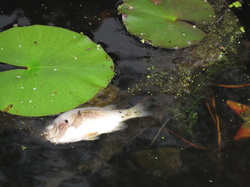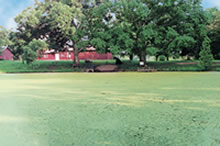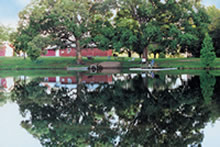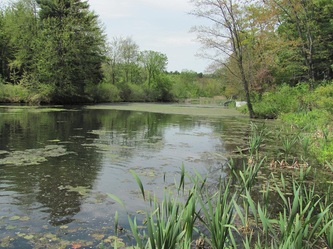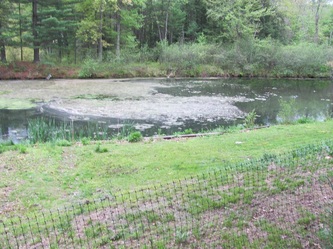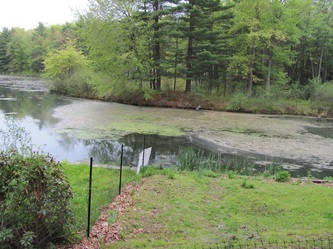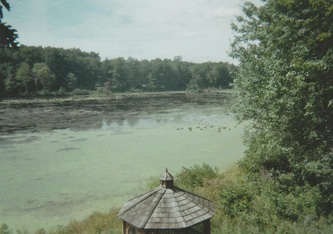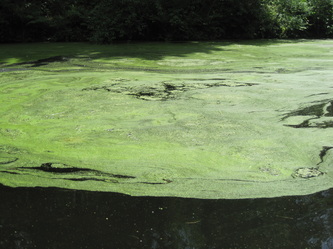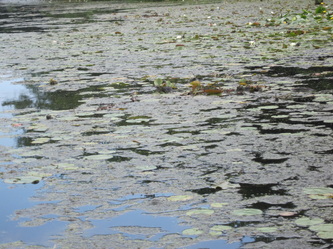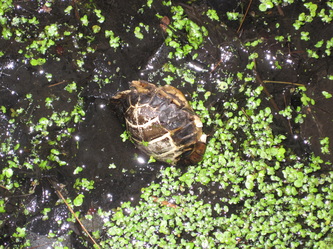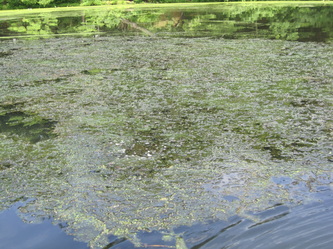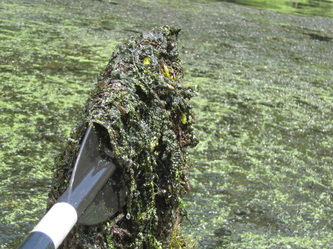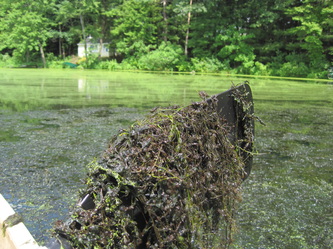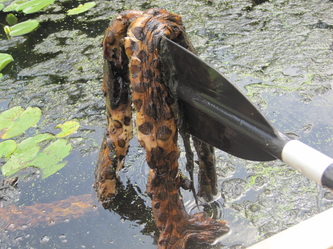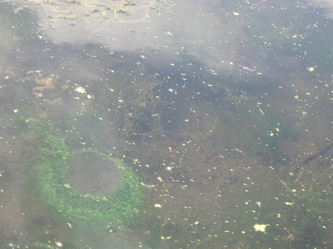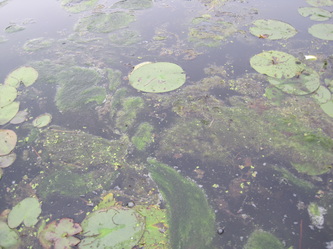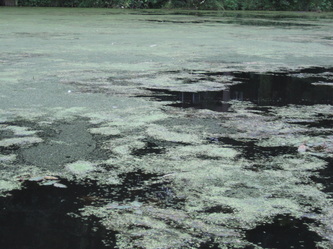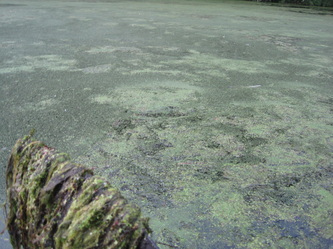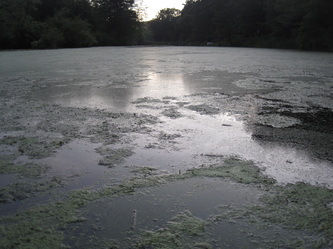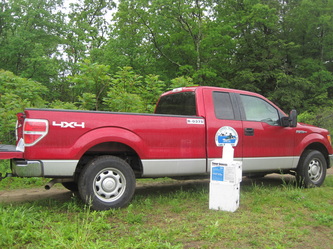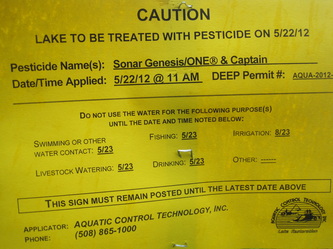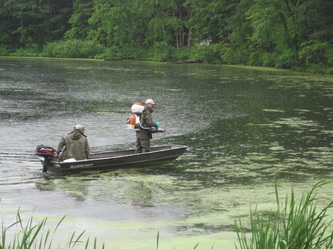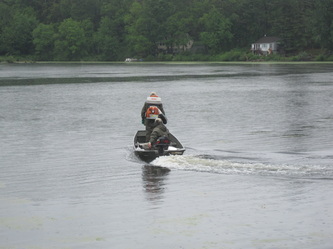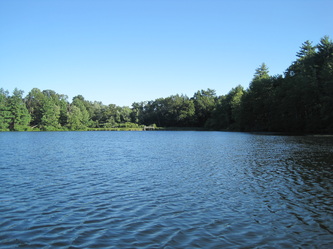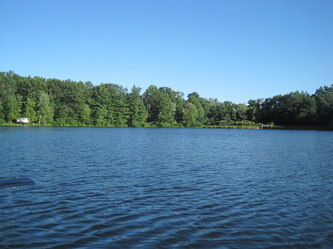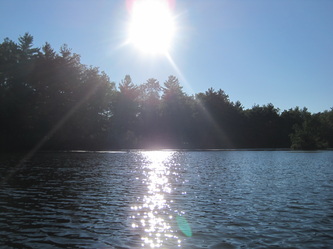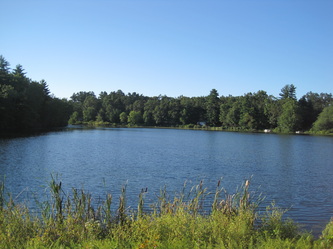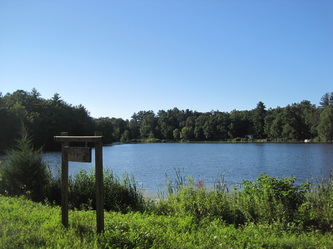Our Beloved Lake is in Trouble...and Needs Your Help!
Problems at Lake Basile
The Lake Basile Association, in conjunction with the Connecticut Federation of Lakes and funded in part by the Connecticut Department of Environmental Protection, first commissioned a lake study in the form of a baseline biological survey that was completed by the environmental consulting firm Aquatic Control Technology, Inc. in the Fall of 2010. The findings of this study were disturbing if not entirely unexpected, given the visible deterioration of the lake seen over the years.
According to the study, the condition of Lake Basile is commonly referred to as “eutrophic”, characterized by high biological productivity, excessive aquatic plant growth, increased sedimentation, and a nutrient-rich mucky bottom. Eutrophication (or “aging”) of a pond is a natural process but can be accelerated due to pollution, development and wildlife activity. This is especially true for enhanced or manmade lakes and ponds where the location was previously a wetland or field, already rich in nutrient stores. The most obvious symptom of eutrophication in Lake Basile is the excessive, uncontrolled growth of aquatic plants, dominated by waterweed, watermeal, duckweed, curly-leaf pondweed (non-native!), algae colonies and other species submersed, floating and emergent species, some of which are considered highly invasive. This is the most obvious focus of potential lake management efforts, however additional concerns include excessive growth of algae, the “filling-in” of the inlet end of the lake, the potential for further water quality degradation and continued eutrophication. Each year untreated these issues continue to worsen, and if left unchecked the lake can be overrun by these excessive and harmful blooms, especially during the summer months when the lake is best to be enjoyed by the public. Generations ago residents and townsfolk would swim in the lake on a hot summer day. Take a look at the photographs below and you can see why this is no longer possible without our ongoing treatment programs. If left unchecked, the lake has the potential to be harmful to native fish species that require a more stable water profile than has developed over time in the lake.
One of the primary purposes of the Lake Basile Association is to address the water quality issues of the lake in order to preserve and protect the wildlife and natural beauty of the lake for generations to come. The lake requires an ongoing remediation process that we primarily fund with resident & member dues and donations, in addition to some community and corporate outreach. Without the necessary funding, we would be unable to continue with the remediation plan outlined in our yearly lake reports and our beloved lake will face an uncertain future at best.
Treatment plan
The lake reports outline recommended treatment options to combat the extensive plant and algae growth in the lake under various cost levels depending on the method. Every year we continue to closely monitor our plant control program using approved aquatic herbicides that are administered by our environmental consulting firm under a permit through the Connecticut Department of Energy and Environmental Protection and local wetlands commissions. Approaches like this have successfully been implemented in several lakes in Connecticut and nationwide, and is considered an environmentally safe alternative that is even used in reservoirs used for drinking water.
As the treatment program generally involves the selective use of a highly-specialized plant-inhibiting agent in a body of water, the process is understandably well-controlled and monitored by environmental scientists and must be formally approved by the DEEP. The treatments have thus far yielded successful results within a short time of application, and the lake can still be used for all recreational uses between treatments. The first year remediation plan was somewhat higher than our ongoing annual treatment costs, and our typical annual costs run in the $3,000-$7,000 range depending on each year's circumstances. No one cares more about the lake and the surrounding environment than the local residents who live near the lake or enjoy the recreational activities that its waters provide, and we ask your help in achieving our dream of restoring Lake Basile to its natural beauty. With your generous help, we can all become an inspiring chapter in the Lake's wonderful story.
Update: Since 2012 the lake has been successfully treated with annual applications of selective aquatic herbicides, which has dramatically improved the water quality as compared to previous years. Future treatments will most likely be necessary and we are actively pursuing alternate treatment options as well to effectively address the Lake's issues in a multi-pronged strategy including mechanically removing algae with a barge & rake system (Hydro-raking), or potential modifications to the outlet dam that will enable the use of winter "draw-down" programs to reduce vegetation. These are longer-term solutions that will vary in effectiveness and costs, and we will require greater commitments from our supporters to ensure the Lake Basile ecosystem remains healthy for wildlife and available for recreational enjoyment for generations to come!
If you would like to know what you can do to help out Lake Basile, please visit our Donations page or email us at info@lakebasile.org.
See below for before and after photographs of lakes who have successfully used similar treatments:
According to the study, the condition of Lake Basile is commonly referred to as “eutrophic”, characterized by high biological productivity, excessive aquatic plant growth, increased sedimentation, and a nutrient-rich mucky bottom. Eutrophication (or “aging”) of a pond is a natural process but can be accelerated due to pollution, development and wildlife activity. This is especially true for enhanced or manmade lakes and ponds where the location was previously a wetland or field, already rich in nutrient stores. The most obvious symptom of eutrophication in Lake Basile is the excessive, uncontrolled growth of aquatic plants, dominated by waterweed, watermeal, duckweed, curly-leaf pondweed (non-native!), algae colonies and other species submersed, floating and emergent species, some of which are considered highly invasive. This is the most obvious focus of potential lake management efforts, however additional concerns include excessive growth of algae, the “filling-in” of the inlet end of the lake, the potential for further water quality degradation and continued eutrophication. Each year untreated these issues continue to worsen, and if left unchecked the lake can be overrun by these excessive and harmful blooms, especially during the summer months when the lake is best to be enjoyed by the public. Generations ago residents and townsfolk would swim in the lake on a hot summer day. Take a look at the photographs below and you can see why this is no longer possible without our ongoing treatment programs. If left unchecked, the lake has the potential to be harmful to native fish species that require a more stable water profile than has developed over time in the lake.
One of the primary purposes of the Lake Basile Association is to address the water quality issues of the lake in order to preserve and protect the wildlife and natural beauty of the lake for generations to come. The lake requires an ongoing remediation process that we primarily fund with resident & member dues and donations, in addition to some community and corporate outreach. Without the necessary funding, we would be unable to continue with the remediation plan outlined in our yearly lake reports and our beloved lake will face an uncertain future at best.
Treatment plan
The lake reports outline recommended treatment options to combat the extensive plant and algae growth in the lake under various cost levels depending on the method. Every year we continue to closely monitor our plant control program using approved aquatic herbicides that are administered by our environmental consulting firm under a permit through the Connecticut Department of Energy and Environmental Protection and local wetlands commissions. Approaches like this have successfully been implemented in several lakes in Connecticut and nationwide, and is considered an environmentally safe alternative that is even used in reservoirs used for drinking water.
As the treatment program generally involves the selective use of a highly-specialized plant-inhibiting agent in a body of water, the process is understandably well-controlled and monitored by environmental scientists and must be formally approved by the DEEP. The treatments have thus far yielded successful results within a short time of application, and the lake can still be used for all recreational uses between treatments. The first year remediation plan was somewhat higher than our ongoing annual treatment costs, and our typical annual costs run in the $3,000-$7,000 range depending on each year's circumstances. No one cares more about the lake and the surrounding environment than the local residents who live near the lake or enjoy the recreational activities that its waters provide, and we ask your help in achieving our dream of restoring Lake Basile to its natural beauty. With your generous help, we can all become an inspiring chapter in the Lake's wonderful story.
Update: Since 2012 the lake has been successfully treated with annual applications of selective aquatic herbicides, which has dramatically improved the water quality as compared to previous years. Future treatments will most likely be necessary and we are actively pursuing alternate treatment options as well to effectively address the Lake's issues in a multi-pronged strategy including mechanically removing algae with a barge & rake system (Hydro-raking), or potential modifications to the outlet dam that will enable the use of winter "draw-down" programs to reduce vegetation. These are longer-term solutions that will vary in effectiveness and costs, and we will require greater commitments from our supporters to ensure the Lake Basile ecosystem remains healthy for wildlife and available for recreational enjoyment for generations to come!
If you would like to know what you can do to help out Lake Basile, please visit our Donations page or email us at info@lakebasile.org.
See below for before and after photographs of lakes who have successfully used similar treatments:
Use the button below to make your tax-deductible donation today! (You will be directed to Paypal's secure site)
Invasive Plants and Algae Blooms at Lake Basile: Pre-treatment, Summer 2011
Treatment at Last!
Thanks to the generous donations we have received, Lake Basile completed its first full-lake treatment in the summer of 2012, and every year since we have had smaller, more localized treatments. See below for pictures from the first Application Day (May 22nd, 2012)!
"Never doubt that a small group of thoughtful, committed citizens can change the world; indeed, it is the only thing that ever has."
- Margaret Mead
"Never doubt that a small group of thoughtful, committed citizens can change the world; indeed, it is the only thing that ever has."
- Margaret Mead
Lake Basile Summer Present Day, Post-Treatment
See the pictures below for the dramatic results from the recent treatments of the Lake - hard to believe this is the same lake from the Pre-treatment photographs!
